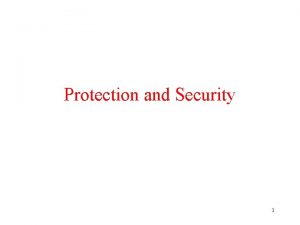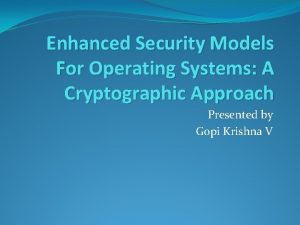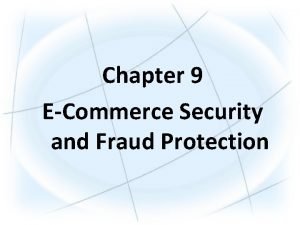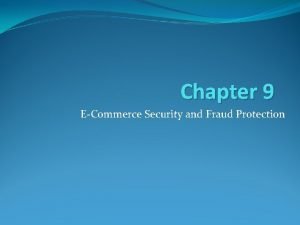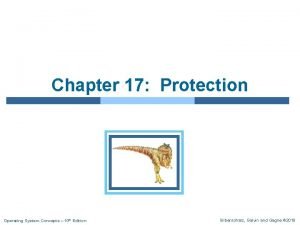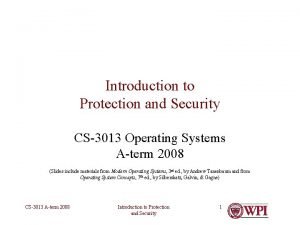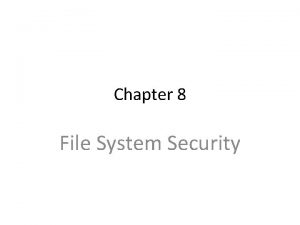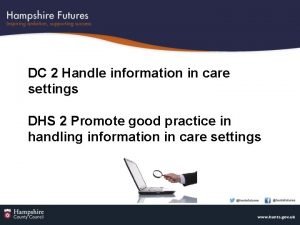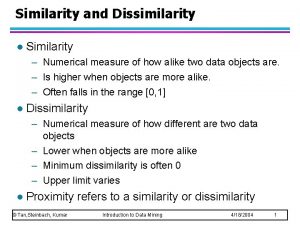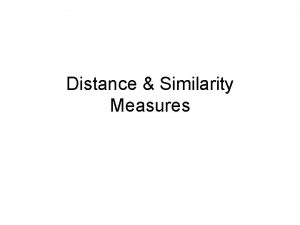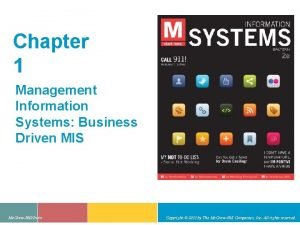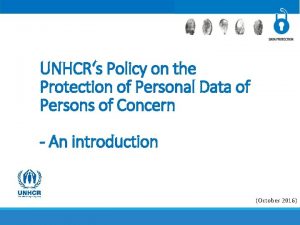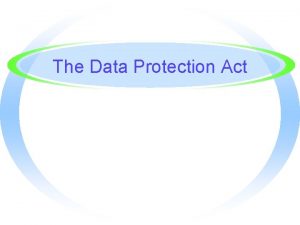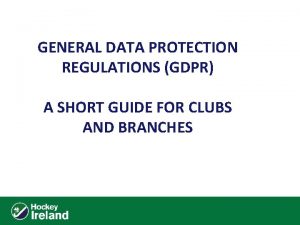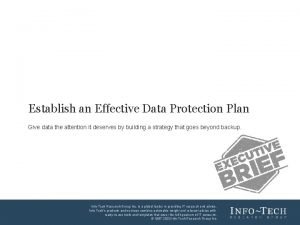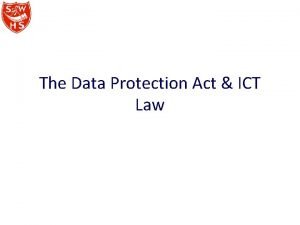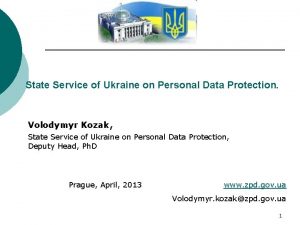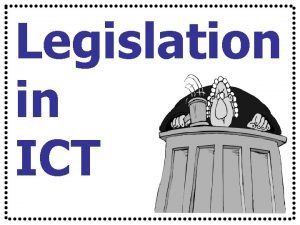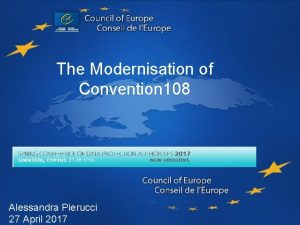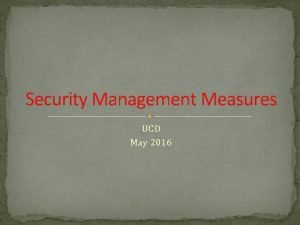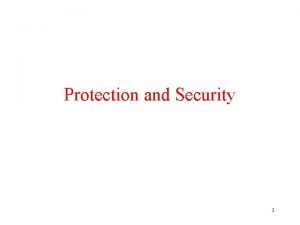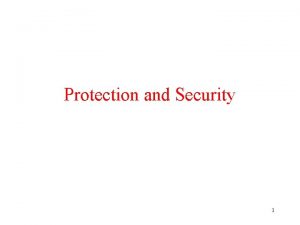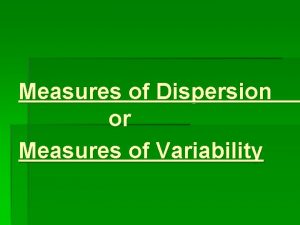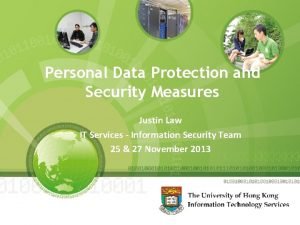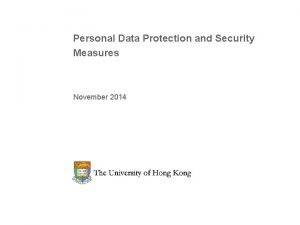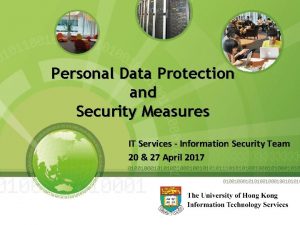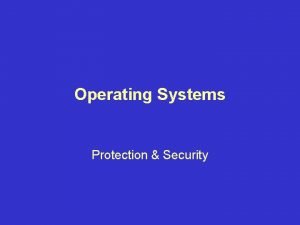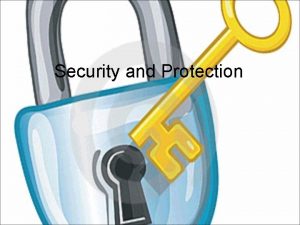Security and data protection measures in the context









































- Slides: 41

Security and data protection measures in the context of ‘Once -only’ and reuse of existing data approaches

The ‘Once-only’ principle The 'Once-only' principle states that citizens and businesses should have the right to supply certain standard information only once to public administrations on the basis that this information will be shared internally and appropriately by public administrations thus eliminating any additional administrative burden. Denmark • Basic Data programme: Examples Making basic information (of citizens and businesses) freely accessible for everyone and for all public authorities (i. e. for commercial as well as noncommercial purposes), by means of 9 connected registers. • Mandatory digital selfservice: Enforcing by law the digital implementation of a certain number of transactions UK Netherlands • The system of 13 base registries: Collection and sharing of citizens and businesses core data across all government authorities, through 13 registers gathering data of persons, businesses, cars, land administrations, maps, income, buildings. • Tell Us Once: Information sharing on births and deaths across government departments, so that citizens are required to provide this information only once to public authorities. • The Digital Government Strategy: Overall programme of change impacting multiple departments across the Civil Service to realise efficiencies through the adoption of digital procedures by default. Source: Study on Administrative burden reduction (EC 2014) 2

Table Of Contents Ø Context & background Ø Objectives Ø Methodology Ø Key findings Ø Case studies Ø Conclusions Ø Wrap up from EUPAN HRWG/IPSG Ø Appendix 3

Context & background 18. 11. 2009 Malmö Ministerial Declaration on e. Government 24 – 25. 10. 2013 Council Conclusions “EU legislation should be designed to facilitate digital interaction between citizens, businesses and the public authorities. Efforts should be made to apply the principle that information is collected from citizens only once, in due respect of data protection rules” “How public administrations can reduce the frequency with which citizens and businesses have to resubmit information to appropriate authorities” Study on e. Government and the Reduction of Administrative Burden (EC-2014) 2009 2010 15. 12. 2010 e. Government Action Plan 2011 – 2015 “Reduction of administrative burdens: applying the principle of “Once-only" registration of data for citizens. ” 2011 2012 2013 2014 2015 06. 05. 2015 Digital Single Market Strategy “The Commission will present a new e. Government Action Plan 2016 -2020 which will include (i) making the interconnection of business registers a reality by 2017, (ii) launching an initiative in 2016 with the Member States to pilot the 'Once-only' principle” “ 70% of the countries analysed in this study were implementing projects or programmes related to the ‘Once-only’ principle” 4

Objectives 1 2 3 To provide an overview on the implementation of the ‘Once-only’ principle (OOP) across European countries, with a particular focus on security and data protection measures. To identify best practices in the area of technology, legislation and organisation regarding security and data protection. To draw key conclusions for Member States. 5

Methodology Desk Research On-line Survey Ø In-depth analysis of studies produced by the Commission (e. g. Study on e. Government and the reduction of administrative burden). Ø To collect views on the main challenges related to security policies and data protection as well as on specific measures and best practices from EU Member States and other European countries. Ø Of a total of 33 countries invited to respond to the survey, we received 27 answers from the following 25 countries (21 EU Member States) : AT, BE, BG, CH, CY, CZ, EE, EL, ES, HR, HU, IE, IS, IT, LV, LU, MT, NL, NO, PT, RO, SI, SK, TR, UK. Ø Case studies on Luxembourg, Austria and Estonia. Case studies Ø In-depth analysis on My. Guichet for Luxembourg and data from Austria and Estonia related to specific case studies identified through the online survey. 6

Key findings Has your country started to implement the OOP? IS FI* Out of a total of 33 European countries, 25 countries have started to implement NO OOP at national level. EE SE* Among those countries, 7 have started LV DK* LT* IE to implement this principle at both UK* NL regional and local levels. PL* DE* BE CZ LU FR* CH AT LI SK HU RO SI HR BG IT PT MK ES TR GR CY MT * Secondary data source (Study on Administrative burden reduction (EC 2014)) Implementing OOP Not implementing OOP Sources: Online questionnaire (KURT SALMON 2015), n=33 Study on Administrative burden reduction (EC 2014) No data available 7

Key findings Is there a strategy/initiatives aimed to implement the ‘Once-only’ principle in your country? Out of a total of 25 European countries: Ø 13 have both a strategy & initiatives in IS place; Ø 2 have only a strategy in place; FI Ø 7 have only initiatives in place; and NO EE Ø 3 did not provide any data. SE* LV DK * LT* IE A few examples of initiatives: UK NL My. Guichet PL DE BE CZ LU X-Road FR* CH AT LI SK HU RO SI ‘Basic Data’ programme HR BG IT ‘Tell us once’ programme PT MK ES TR GR CY MT * Secondary data source (Study on Administrative burden reduction (EC 2014)) Both a strategy & initiative(s) exist Only initiative(s) exist(s) Only a strategy exists No data available Sources: Online questionnaire (KURT SALMON 2015), n=33 Study on Administrative burden reduction (EC 2014) 8

Key findings Is there a legislation supporting the implementation of the OOP in your country? Out of a total of 25 European countries, IS 13 have legislation in place supporting the implementation of the ‘Once-only’ principle. FI NO EE SE LV DK LT IE A few examples of legislation: UK The Act of 5 May 2014 on the establishment of the principle of the unique data collection NL PL DE BE CZ LU FR CH LI HU RO SI The Decree-Law 73/2014 HR BG IT Law of State Information Systems of 2002 SK AT PT MK ES TR GR e-Government act of 1 March 2004 CY MT A piece of legislation exists No specific legislation Sources: Online questionnaire (KURT SALMON 2015), n=33 No data available 9

Key findings What types of data are supplied only once by citizens and/or businesses? Country Austria Latvia Estonia Netherlands Luxembourg Romania Spain Croatia Cyprus Belgium Sweden Bulgaria Slovakia Slovenia Turkey Czech Republic Portugal Italy Total Personal data related to citizens Identification data related to businesses Geographic data Fiscal/Financial data Health data Other 16 13 9 7 6 6 As part of ‘other’, data related to vehicles were cited by two different countries as data supplied only once by citizens and/or businesses. Source: Online questionnaire (KURT SALMON 2015), n=25 10

Key findings Is there, in your country, a law establishing authentic sources? Number of answers For each type of aforementioned data, 12 the establishment of related authentic sources is widely supported by a specific 10 law. 8 6 4 Yes No 2 Don’t know/No opinion No answer Note: An authentic source is a high quality database, accompanied by explicit guarantees ensuring for its quality assurance and that contains essential and/or frequently-used data pertaining to persons, institutions, issues, activities or occurrences. Personal data related to citizens Identification data related to businesses Geographic Fiscal/Financial (including data address) data Source: Online questionnaire (KURT SALMON 2015), n=25 Van Duivenbode & de Vries, 2004 Health data 11

Key findings How are data related to citizen/businesses provided? Personal data related to citizens Data are collected in existing registers and shared across public administrations 52% (13) Identification data related to businesses Data are collected in existing registers and shared across public administrations 50% (11) AT, BG, CY, EE, ES, HR, LT, LU, NL, RO, SI, SK, TR 4% Other (1) CY, LU 8% (2) Declarative data AT, BE, CY, EE, HR, LU, SI, SK, TR 36% (9) Data are collected in existing registers and made available to citizens/business in order to perform an electronic public service AT, BG, CY, CZ, EE, HR, LT, LU, NL, SI, SL 5% Declarative (1) data CY AT, BE, CY, EE, HR, LU, NL, RO, SI, SL 45% (10) Data are collected in existing registers and made available to citizens/business in order to perform an electronic public service Personal data related to citizens and identification data related to businesses are primarily collected in existing registers and shared across public administrations but also, to a minor extent, made available to citizens /businesses in order to perform an electronic public service. Note: ‘Declarative data’ refers to the data provided by the citizens/businesses themselves, for example in a personal space, in order to be reused afterwards for other electronic public services. Source: Online questionnaire (KURT SALMON 2015), n=25 12

Key findings How does your country concretely implement the consent of ‘data subject’? IS FI Out of a total of 25 European countries, NO 10 countries apply the principle that explicit EE SE consent has to be given by the ‘data DK subjects’ before their related data can be LT IE UK processed, whereas this processing is set by NL PL DE BE default by law in 6 other countries. CZ LU Depending on the concerned data, FR CH AT LI SK HU RO SI HR 3 additional EU countries require the explicit consent of ‘data subjects’ if the processing LV BG IT PT MK ES TR GR of those data is not imposed by law. CY MT Explicit consent to be given By law, no explicit consent needed Explicit consent to be given or imposed by law No answer Source: Online questionnaire (KURT SALMON 2015), n=25 13

Key findings What are the main barriers that your country aims to overcome in order to ensure the implementation of the OOP? What are the measures taken to overcome these barriers? Organisational barriers (21) Measures proposed Main barriers encountered › Lack of resources › Lack of willingness to share data with other administrations Semantic barriers (16) › Inconsistencies in data elements definition › Different data models Legal barriers (13) Technical barriers (9) › Specific provisions related to the processing of personal data › Legacy systems › No measures mentioned › Lack of harmonisation of different processes › Identification of information ownership › Establishment and promotion of common vocabularies › Common strategy coordinated by one entity Other barriers mentioned: implementation cost related to the implementation of the OOP and lack of budget. Source: Online questionnaire (KURT SALMON 2015), n=25 14

Key findings What approach is currently used by your country to implement the OOP? Combination of both Front & Back-office integration Front-office integration IS 1 (5%) FI Don’t know/ No opinion 3 (16%) 11 (58%) N O EE SE Other LV DK 1 (5%) LT IE UK 3 (16%) NL PL DE BE Back-office integration CZ LU FR CH AT L I A combination of both Front and Back-office HU RO SI HR IT PT SK M K ES BG GR integration is used by a vast majority of countries to CY implement the OOP. In fact, this approach facilitates the different applications and related processes used to implement the OOP. TR M T Combination Back-office integration N/A Other Source: Online questionnaire (KURT SALMON 2015), n=25 Front-office integration 15

Key findings What security measures are applied in order to ensure authentication and authorisation? Authentication Strong authentication via Authorisation different means (via tokens, smartcards, SMS, etc. ) as well 16 (62%) 6 (22%) as via e. ID card. 3 (11%) 7 (26%) 2 (8%) 4 (15%) Strong authentication Username/ password 4 (15%) Other measures 1 (4%) No answer Three countries (PT, IE, IT) use a two-factor authentication depending on the system used and the type of data held. RBAC ABAC 10 (37%) Other measures Access Control Lists No answer Other measures depend on the application and system used, and the type of data held. One country (LU) is using both RBAC and ACL. Source: Online questionnaire (KURT SALMON 2015), n=25 16

Key findings What security measures are applied in order to ensure traceability, non-repudiation and integrity? Traceability & Non-repudiation Integrity 19 (44%) 10 (38%) 4 (15%) 5 (12%) 4 (9%) 11 (26%) 4 (9%) Log files Audit trails e. Signature Timestamping No answer 10 countries use a combination of these different measures in order to ensure traceability and non-repudiation. 12 (46%) e. Signature Other No answer 10 countries use e. Signature in order to ensure data integrity (71% of the countries having replied to this question). Source: Online questionnaire (KURT SALMON 2015), n=25 17

Key findings What security measures are applied when accessing data (confidentiality measures) and transmitting data from the location where they are stored to a public administration? Data transmission Confidentiality 16 (42%) 9 (35%) 4 (11%) Encrypted data 6 (23%) 7 (27%) Restricted access to data 14 (37%) Confidentiality agreements 4 (15%) No answer 10 countries currently use a combination of these different measures in order to ensure confidentiality of data. Secure dedicated network Secured communication protocol (e. g. HTTPS) Other No answer A secure dedicated network is widely used when transmitting data from the location where they are stored to a public administration. (47% of the countries having replied to this question). Source: Online questionnaire (KURT SALMON 2015), n=25 18

Key findings Does your country implement an encryption system in order to protect user’s personal data? Does this implementation provide the possibility to access users’ data using a Key Escrow system? 11 (42%) 2 (18%) SK, LU 1 11 (42%) 5 (45%) 4 (36%) 4 (15%) Yes No Don’t know/ No opinion The use of Key Escrow System is not imposed by any legal basis (for the 11 countries having implemented a Key Escrow System in order to protect user’s personal data). 1 An encryption system is only used on My. Guichet. Source: Online questionnaire (KURT SALMON 2015), n=25 19

Case study N° 1: Luxembourg Ø Context on the ‘Once-only’ principle in Luxembourg Art. 4. (2) prescribed that authentic data already 02. 08. 2002: 19. 06. 2013: Act relating to the protection of individuals in relation to the processing of personal data Law on the Register of physical persons contained in the register of physical persons have to be reused by public administrations and that these administrations cannot ask the citizen to produce 19. 12. 2002: once more pieces to prove the exactitude of the data Law on the Register of companies … already existing in the register. 2013 2014 2015 2008 2011 04. 02. 2013: 06. 12. 2013: 03 -04. 06. 2014: 24. 07. 2015: Roll out of Guichet. lu (citizens) Roll out of Guichet. lu (businesses) Roll out My. Guichet (v 3) Adoption of the new Government programme Adoption of “Digital Lëtzebuerg” Adoption of five principles aimed at accelerating state modernisation and the digitisation of administrative procedures (including the OOP) 1. Digital by default; 2. Once-Only principle; 3. Transparency; 4. Improved electronic payment methods; 5. « My. Guichet » as the main channel of interactions with public administrations 20

Case study N° 1: Luxembourg Ø The ‘Once-only’ principle into action: My. Guichet • Single Point of Contact (SPOC) for nearly all administrative procedures in Luxembourg. • Main building block and backbone for the implementation of the ‘Once-only principle’ for administrative procedure. • The solutions offered by My. Guichet will be systematically extended to more and more online services in the coming years. Citizens Businesses Information Guidance on procedures Catalogue of procedures Administrative procedures Authentic sources Administrations 21

Case study N° 1: Luxembourg What type of data are supplied only once by citizens and/or businesses? Data are collected in one central register for personal data related to physical persons and shared across public administrations (e. g. national registry) Personal data related to citizens Data are collected in existing registers and made available to citizens to perform an electronic public service (e. g. national registry) Declarative data (e. g. descriptive data, bank account, fiscal data) Data are collected in the company register and the e. VAT register and shared across public administrations Data supplied only once by citizens and/or businesses Identification data related to businesses Data are collected in the company register and the e. VAT register and made available to citizens/business to perform an electronic public service (e. g. VAT balance sheet, tax credit, business permit applications) Declarative data (e. g. NACE code) Fiscal/Financial data Data are collected in existing registers and shared across public administrations Declarative data In the future, criminal records and business permit applications aim to be shared across public administrations. Payslips and pension are provided as authentic source only. 22

Case study N° 1: Luxembourg What approach is currently used by your country to implement the OOP? Ø Combination of both front- and back-office approaches: (i) Integration in front-office applications of citizens and businesses data provided by authentic sources or by declarative data in order to pre-fill forms. (ii) Integration of citizens and businesses data in back-office applications after consent of the data subject. Ø APIs for more and more databases or registers containing authentic sources will be implemented. Back Office Front Office Citizens & Businesses Administrations Authentic sources Private space Private Assistant Authentic source Professional Authentic source Back Office Back-Office Administration National Register Driving licence Tax credit … VAT balance sheet Taxi waiting list … 23

Case study N° 1: Luxembourg What security measures are applied on My. Guichet? Authentication Strong authentication › Electronic ID card (using Lux. Trust certificates) › Lux. Trust solutions (Smartcard, Signing stick, Token) Authorisation (access control) › ACLs (Access Control Lists) › RBAC (Role-based access control) Confidentiality › Restricted access to data › Sensitive personal data encrypted (e. g. the SSL protocol). Traceability & Non-repudiation › e. Signature › Log files Integrity › Time stamping added before the document transmission › e. Signature 24

Case study N° 2: Austria Ø Context on the ‘Once-only’ principle in Austria 03. 2001: The portal was awarded in Berlin the BIENE 2006 in Gold Roll-out of HELP. gv. at; an interface between authorities and citizens for the best barrier-free German language information portal. 01. 03. 2004: 12. 2013: Adoption of Austria's E-Government Act: Federal Act on Provisions Facilitating Electronic Communications with Public Bodies Adoption of the Working programme of the Austrian Federal Government for 2013 - 2018 … 2010 2013 2015 01. 2010: 05. 2014: Roll-out of USP. gv. at; the one-stop-shop Business Service Portal Adoption of e. Government strategy; see “Administration on the Net – The ABC guide of e. Government in Austria” Main pillars of the Austrian implementation of the 'once only' principle: 1. Full respect of data protection laws and regulations. 2. Interconnection of base registers, e. g. through harmonised and standardised interfaces based on open standards. 25

Case study N° 2: Austria Ø The ‘Once-only’ principle into action: HELP. gv. at and USP. gv. at • The Business Service Portal (www. usp. gv. at) serves as a single entry point for businesses to the administration whereas the HELP. gv. at website offers online services according to the one-stop principle to anyone who wants to find out more about administrative procedures in Austria. • By offering information, transaction and personalised services, these portals intend to support citizens as well as to help businesses to fulfil their legal obligations and to reduce the administrative burdens for both of them. Citizens & Businesses Single-Sign-On (SSO) Information & personalised services Information & transaction services Access to electronic procedures Business Portal Citizen Portal Administrations 26

Case study N° 2: Austria What type of data are supplied only once by citizens and/or businesses? Personal data related to citizens Identification data related to businesses Data supplied only once by citizens and/or businesses Geographic data Data are collected in existing registers and shared across public administrations Data are collected in existing registers and made available to citizens/business in order to perform an electronic public service Data are collected in existing registers and shared across public administrations Fiscal/Financial data Health data Data are collected in existing registers and made available to citizens/business in order to perform an electronic public service Data are collected in existing registers and shared across public administrations All data categories could possibly be relevant for implementing the OOP (no sector-related restrictions) 27

Case study N° 2: Austria What approach is currently used by your country to implement the OOP? Ø Combination of both front- and back-office approaches: Back-Office is the most common solution, but there also applications rather following the front-office approach. Back-Office Approach is being done by administration-internal requests to base Registers based on common interfaces and specifications. Ø On a very high level, Austria encourages a distributed solution based on interconnection of various registers. Presentation layer HTML/ XFORMS User Interface Sign XML (Olapp) VALIDATE Form Service validation (check at browser level – store, restore, print) Identify XML (Olapp) SEND Citizen card Secure viewer Business logic: Validation (semantc, complete), Signature proof (MOA-SP), sending Register, Database, Lightweight Directory Access Protocol (LDAP) , etc. Olapp/PVP XML/Olapp validate, send External Partner Dispatcher (Inbox and confirmation) Back-Office application Olapp/PVP Olapp/PVP P pp /PV Ola Backoffice End-user Workflow, applications, etc. 28

Case study N° 2: Austria What security measures are applied on the citizen portal? Authentication › Multi-factor authentication mechanisms for citizens and businesses › At least username/password for public servants willing to access data Authorisation (access control) › No need for a specific assignment of access rights for citizens (strong authentication) Confidentiality › Authorisation of public servants based on a rights model set out by the specific application › Data encrypted (e. g. TLS transport channel). Caveat: depends on the system Traceability & Non-repudiation Integrity › e. Signature Caveat: depends on the individual (citizens vs. Public servants) › e. Signature 29

Case study N° 3: Estonia Ø Context on the ‘Once-only’ principle in Estonia The first version of the Public Information Act took effect in January 2001. A newly revised, 31. 05. 2000: updated Public Information Act entered into force on 1 January 2008. Adoption of the Population Register Act Since then, it became compulsory to connect all public and private sector base registries to XRoad, Estonia’s data exchange platform: § 43 (2) indeed mentions that the “establishment of 15. 11. 2000: separate databases for the collection of the same data is prohibited”. Adoption of the Public Information Act … 12. 02. 2003: 17. 02. 2011: 04. 2014: Adoption of the Personal Data Protection Act Adoption of the Spatial Data Act Adoption of the Digital Agenda 2020 for Estonia - Estonia's current digital strategy 2010 2013 2001: 22. 12. 2011: 09. 2013: Roll-out of the Data exchange layer X-Road Adoption of the Estonian State Information System interoperability framework v 3. 0 Adoption of the Estonian Entrepreneurship Growth Strategy 2014 -2020 2015 In order to reduce the administrative burden, we will try exclude the situation where the data that has once been submitted to the state has to be submitted again. 30

Case study N° 3: Estonia Ø The ‘Once-only’ principle into action: X-Road data exchange layer • X-Road is a platform-independent secure data exchange layer, allowing institutions/people to securely exchange data and ensuring access to the data maintained and processed in state databases. • Public and private sector enterprises and institutions can connect their information system with the XRoad. This enables them to use X-Road services in their own electronic environment or offer their eservices via the X-Road. MISP stands for Mini Information System Portal software. This is a simple user interface that has mechanisms for user authentication and authorisation. 31

Case study N° 3: Estonia What type of data are supplied only once by citizens and/or businesses? Personal data related to citizens Identification data related to businesses Data supplied only once by citizens and/or businesses Geographic data Data are collected in existing registers and shared across public administrations (many registers contain personal data) Data are collected in existing registers and made available to citizens/business in order to perform an electronic public service Data are collected in existing registers and shared across public administrations (e. g. Estonian Business Register, based on the Estonian Commercial Code) Data are collected in existing registers and made available to citizens/business in order to perform an electronic public service Data are collected in existing registers and shared across public administrations (e. g. Land Cadastre, Spatial data registers) Data are collected in existing registers and made available to citizens/business in order to perform an electronic public service Data are collected in existing registers and shared across public administrations (e. g. Register of Taxable Persons) Financial/ Fiscal data Heath data Data are collected in existing registers and made available to citizens/business in order to perform an electronic public service Data are collected in existing registers and shared across public administrations (e. g. Estonian Health Information System) Data are collected in existing registers and made available to citizens/business in order to perform an electronic public service 11234 data objects in the sense of the Personal Data Protection Act are registered in the State Information System (all information systems that are connected to X-Road). 32

Case study N° 3: Estonia What approach is currently used by your country to implement the OOP? 33

Case study N° 3: Estonia What security measures are applied to the X-Road data exchange layer? Authentication Strong authentication › Public Key Infrastructure (certificates) › Electronic ID card for citizens Confidentiality › Restricted access to data Authorisation (access control) › Access to types of data in a register by services in the State Information System is agreed previously between the information system owners and based on consent of the data owner. Traceability & Non-repudiation › Log files Integrity › Depends on an information system, on the user rights. › A person (and the supervisor) has control over the data and can thus trace illegal transactions with his/her data and notify a supervisor to take legal action against the offender. 34

Conclusions Conclusion 1 Ø 70% of the countries analysed in a study conducted by the European Commission (“e. Government and the Reduction of Administrative Burden”) were implementing projects or programmes related to the OOP in 2013. Ø This percentage has slightly increased in the course of 2015 with new countries having started to implement the OOP (e. g. Sweden). Conclusion 2 Ø Most of the countries implement the OOP primarily for personal data related to citizens as well as for identification data related to businesses. Ø For these types of data, the establishment of related authentic sources is widely supported by a specific law. Ø Overall, 25 countries out of a total of 33 European countries (76%) have now started to implement the OOP at national level. Conclusion 3 Ø Personal data related to citizens and identification data related to businesses are primarily collected in existing registers and shared across public administrations but also, to a lesser extent, made available to citizens /businesses in order to perform an electronic public service. Conclusion 4 Ø Organisational barriers are the first type of barriers that countries aim to overcome in order to ensure the implementation of the OOP. Ø This confirms the results of the study conducted by the European Commission on e. Government and the Reduction of Administrative Burden. 35

Conclusions Conclusion 5 Ø A combination of both Front and Back-Office integration is currently used by a majority of countries to implement the OOP. Ø This approach facilitates the different applications and related processes used to implement the OOP. Conclusion 7 Conclusion 6 Ø Strong authentication mechanisms (e. g. single-use password, e. ID card, etc. ) are used by a wide majority of countries to identify who is accessing the data and to ensure that they are who they say they are. Ø However, a few countries still only authenticate users by means of a username and password. Conclusion 8 Ø e. Signature is broadly used to ensure that information can be relied upon and is accurate and complete (integrity). Ø Confidentiality of data is primarily ensured by encryption in order to ensure that none of the data can be deciphered. Ø e. Signature is also used in order to prevent intervening persons or systems to deny or challenge their access to authentic data sources (non-repudiation). Ø Encryption systems provide the possibility to access users’ data by authorised third parties using a Key Escrow system in only two countries (LU & SK). 36

Wrap up from EUPAN HRWG/IPSG (1/2) Meeting held on 16 th October 2015 Ø Ø Good practices aimed at implementing the OOP at national level: • France allows SMEs to participate to e. Procurement procedures by providing their identification number (only data requested). • In Latvia, citizens are able to perform their annual income declaration in a few clicks (declaration forms pre-filled with the information provided by citizens in the past). • In the Netherlands, all communications between citizens and public administrations related to tax declarations aim to digital, as recently declared by the State Secretary of Tax Policies in the Netherlands. Role of legislation in the implementation of the OOP: • In Latvia, legislation is key to define technical requirements and to ensure interoperability between systems so that the data supplied by citizens and businesses can be efficiently reused. • In Bulgaria, on the contrary, legislation represents a barrier to the implementation of the OOP since it stipulates that data from citizens and businesses can only be reused by a public administration if the latter made this request, leaving no space for proactivity. October 2015 37

Wrap up from EUPAN HRWG/IPSG (2/2) Meeting held on 16 th October 2015 Ø Challenges related to the implementation of the OOP at national level: • In the Netherlands, trust and security issues are continuous concerns. • Belgium highlighted one organisational measure that is recommended to other countries: Only a selected number of civil servants should have access to citizens’ or businesses’ data to avoid potential abuse. In case a civil servant is changing position in the administration, then his or her access rights should be reviewed based on strict procedures. • Ø In Bulgaria, the lack of harmonised processes is the main challenge identified. Recommendations for a better implementation of the OOP: • Latvia recommended fostering cooperation between the different level of administrations, i. e. national, regional and local, enhancing their knowledge and communicating on the benefits of implementing the OOP. • Bulgaria suggested to put in place a development training programme for policy, legal and IT units to promote an integrated approach to implementing OOP. • France supports an integrated approach in order to break silos within national administrations. • The Netherlands highlighted the importance for the different Member States to share their best practices between each other. October 2015 38

Appendix: Glossary (1/2) Ø Authentication: Aims to identify who is accessing the data and ensure that they are who they say they are. Ø Authorisation: Aims to give adequate access rights to end-users who are accessing authentic data sources and verify whether they have the rights to do what they are trying to do. • Role-Based Access Control (RBAC) is an approach to restrict system access to authorised users. Permission to perform certain operations is in fact assigned to specific roles. • Attribute-Based Access Control (ABAC) is an approach to determine access control based on the attributes of involved entities. It aims to overcome the limitations of the classical access control models such as RBAC. • Access Control Lists (ACL) is a table defining, for a computer operating system, which access rights each user has to a particular system object, such as a file directory or individual file. Each object has a security attribute that identifies its access control list. The list has an entry for each system user with access privileges. Ø Integrity: Aims to ensure that information can be relied upon and is accurate and complete. Ø Traceability: To chronologically inter-relate any transaction on authentic data sources to a person or system that performed the action in a way that is verifiable. October 2015 39

Appendix: Glossary (2/2) Ø Ø Non-repudiation: Aims to prevent the intervening person or system from accessing authentic data sources in an event or action to deny or challenge their access to authentic data sources. • Audit trail (also called audit log): It is a chronological record, set of records, and/or destination and source of records that provide documentary evidence of the sequence of activities that have affected at any time a specific operation, procedure, or event. • Timestamping: Refers to the use of an electronic timestamp to provide a temporal order for a set of events. Confidentiality: Aims to prevent unauthorised access to information stored in authentic data sources. • Encrypted data: Transferred data is encrypted to ensure that none of the data can be deciphered. • Restricted access to data: Access to data is limited only to a restricted set of users. • Confidentiality agreements: Confidentiality and non-disclosure agreements to be signed when accessing specific data. October 2015 40

With the support of: Centre Des Technologies de l'information de l'Etat Kurt Salmon 1, rue Mercier L - 2144 - Luxembourg 41, Zone d’activité Am Bann L-3372 Leudelange Luxembourg www. ctie. public. lu www. kurtsalmon. com Marc Blau Marc. blau@ctie. etat. lu Gérard Soisson Gerard. soisson@ctie. etat. lu Alessandro Zamboni Senior Manager T+352 621 321 053 Ludovic Mayot Senior Consultant T +352 691 321 007 Céline Monteiro Consultant T +352 691 321 210 Alessandro. zamboni@kurtsalmon. com Ludovic. mayot@kurtsalmon. com Celine. monteiro@kurtsalmon. com 41
 Privatesecurity
Privatesecurity Self protection measures
Self protection measures Repeated measures design
Repeated measures design Presupposition examples sentences
Presupposition examples sentences Security and protection in operating system
Security and protection in operating system Security and protection in operating system
Security and protection in operating system E commerce security and fraud protection
E commerce security and fraud protection E-commerce security and fraud protection
E-commerce security and fraud protection Security and protection in operating system
Security and protection in operating system Protection and security in operating system
Protection and security in operating system File protection and security
File protection and security High context vs low context culture ppt
High context vs low context culture ppt Communicating across generational differences
Communicating across generational differences Paraverbal adalah
Paraverbal adalah Ahpsi
Ahpsi Building security measures
Building security measures Data protection act in health and social care settings
Data protection act in health and social care settings An “evil twin” in the context of computer security is:
An “evil twin” in the context of computer security is: An “evil twin” in the context of computer security is:
An “evil twin” in the context of computer security is: Wireless security in cryptography and network security
Wireless security in cryptography and network security Security policy and integrated security in e-commerce
Security policy and integrated security in e-commerce Similarity and dissimilarity measures in data mining
Similarity and dissimilarity measures in data mining Smc vs jaccard
Smc vs jaccard What is data converted into a meaningful and useful context
What is data converted into a meaningful and useful context Unhcr data protection policy
Unhcr data protection policy Data protection act 8 principles bbc bitesize
Data protection act 8 principles bbc bitesize Raid system of data protection
Raid system of data protection Data protection policy
Data protection policy Data protection plan
Data protection plan Teach ict data protection act
Teach ict data protection act Azure data
Azure data Data protection
Data protection State service of ukraine on personal data protection
State service of ukraine on personal data protection Data protection act ict
Data protection act ict European data protection office edpo
European data protection office edpo Convention 108 data protection
Convention 108 data protection Hát kết hợp bộ gõ cơ thể
Hát kết hợp bộ gõ cơ thể Ng-html
Ng-html Bổ thể
Bổ thể Tỉ lệ cơ thể trẻ em
Tỉ lệ cơ thể trẻ em Voi kéo gỗ như thế nào
Voi kéo gỗ như thế nào Tư thế worms-breton
Tư thế worms-breton




